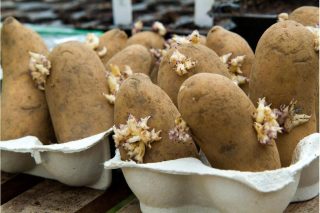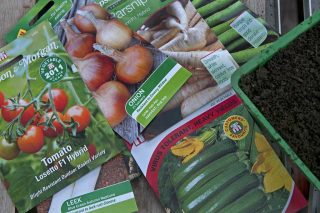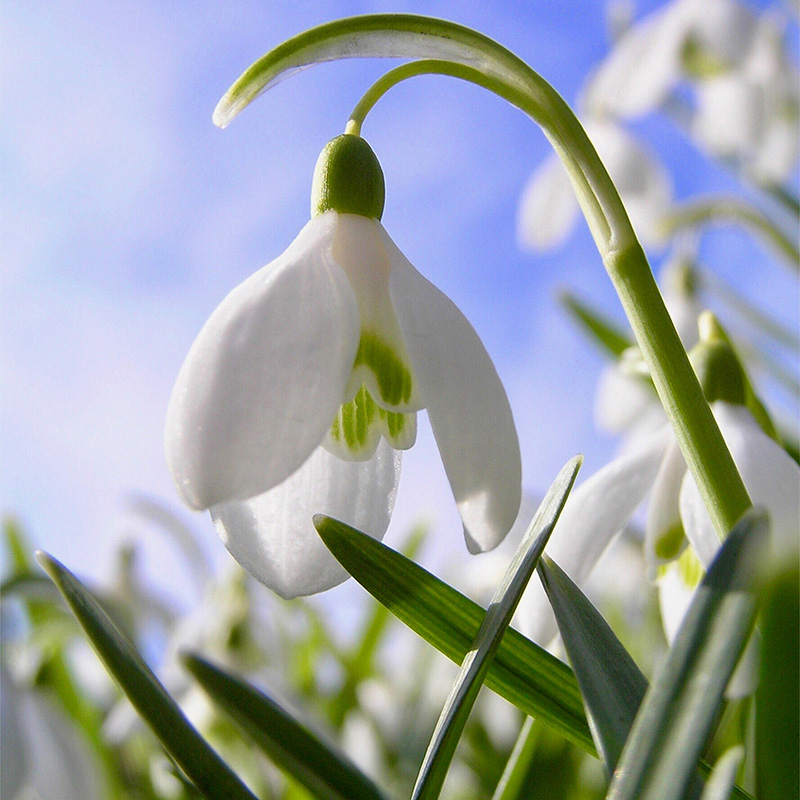This month’s gardening feature has been written by Carolyne Neill.
Caro offers advice in this article to ‘terrified gardeners or newbies’.
Having lived in Roseland since 2010 I have certainly used trial and error to see what works in a very windy garden fairly near the sea.
Now to your garden. All the gardeners who can sit and critique Monty on a Friday night probably know either as much if not more than me. Yes, I too am guilty of this behaviour. Glass of wine in one hand and pencil in the other just in case I do see something new.
So let us begin. What to do first? Well, what do you want to grow? Think about flowers, fruit and veg. Look through some of the seed catalogues. (Parkers, Suttons, Moles). You can send for catalogues or view them online.
 If you want to try vegetables, I would recommend you buy some seed potatoes. No! not the ones from the back of the kitchen cupboard. They may carry disease; they are usually soft and a bit mouldy following a lengthy sojourn lying in state at the back of the cupboard. They are not going to give you good healthy plants or indeed many spuds after all your effort.
If you want to try vegetables, I would recommend you buy some seed potatoes. No! not the ones from the back of the kitchen cupboard. They may carry disease; they are usually soft and a bit mouldy following a lengthy sojourn lying in state at the back of the cupboard. They are not going to give you good healthy plants or indeed many spuds after all your effort.
Now let’s chit them. This just means put them somewhere bright and dry. Let them sprout. The windowsill is where I do mine. Once you try your own potatoes no others will beat the taste. A plate of freshly dug spuds warm from the pan with a generous knob of butter and some freshly chopped mint. Heaven on a plate I promise you. Tip: when buying seed potatoes look for Early Blight Resistant. It will say this on the pack. The seed catalogues and garden centres have good ranges at this time of year.
Now to the garden. I imagine it can be a bit of a worry knowing where to start. It can be less daunting if you tackle the garden in a systematic way. Get some paper and roughly divide your garden into four on the paper and plan what goes in the first quarter. A simple plan would be Spring Planting, Summer Planting, Autumn Planting and Winter Planting. In each area it becomes easier to know what goes where.
The days are lengthening and this means the weeds will be starting to grow steadily. Start pulling them up or digging out the thugs gently with a hand trowel. This will pay dividends in the long run. Tidy up your plot. Don’t forget if you have space to leave a little area to grow wild. This will provide shelter and food for wildlife. If you are going to grow flowers try to make sure most of your flowers are single rather than double flowering. This is so much better for the wildlife. You want butterflies in your garden? Make sure you give them lunch.
I am not a fan of large scale digging in gardens. It is too much like hard work and disturbs delicate soil and eco structures. It is much better to cover areas you intend to use to exclude light which inhibits weed growth and warms up soil. Old cardboard, old paper or old carpet all work well. put a few stones on top of whatever you choose so it doesn’t blow away in the wind.

Seeds are the next thing to get going. Flowers or vegetables? A combination of the two? I would suggest you try some salad and herbs seeds that germinate easily and feed your family fairly cheaply. They taste much better and are so much fresher than the ones you buy in the shops. Think about lettuce, spring onions, chives, coriander and parsley. Tip: read the information on the packet -it is there to help.
How to start? Get some good quality SEED compost from the garden centre. Sieve it. A garden sieve is a useful bit of kit to buy at this point. Fill your seed trays with the seed compost. No seed trays? Empty fruit trays or tomato trays work well. Just remember to put a couple of sheets of paper kitchen towel at the bottom of each tray. Press the compost down and make sure the corners are filled, press down with a piece of cardboard to get the compost level. Give the compost a good soak with water and leave to drain.
Now for the seeds. The exciting bit. You did read the packet, didn’t you? Sow seeds thinly on top of your trays. Just sprinkle it with your fingers. Does the packet say to cover the seeds? If so, how much compost should be on the top? Remember it tells you on the packet. At this point I would recommend you try a mixed salad mix, an oriental salad mix, an herb perhaps parsley, chives, and a spring onion. Why? The seeds are easy to find, quick to grow, they really do taste good so you will use them.
Spritz over the compost gently with an old clean squeezy bottle so as not to disturb your seeds. Label your tray – you will forget what your seeds are otherwise. Believe me I have done it. Put the tray in a warm place if you don’t have a greenhouse. A sunny windowsill is fine. Cover the tray with a clear plastic bag as this stops the tray drying out too quickly.
Keep an eye on your seed tray as different seeds germinate at different rates. Don’t let the trays dry out. If you need to water them, sit the tray in an inch of water rather than watering from the top as this can cause something called damping off and your seeds will not germinate well if at all.
When your seeds germinate the first two leaves are called seed leaves. When you have four leaves it is time to move the little plants to a fresh compost tray to grow on. Hold one of the seed leaves gently and with a pencil gently push the seedling up out of the compost. Make a hole with the pencil in the fresh compost and gently move the seedling into the hole trying to keep all the tiny root hairs intact. This is how the little plants get food and water.
Once you get over the shock that you actually have your own little plants growing, I would suggest you sow your salad seeds little and often. Often being every 2 or 3 weeks and you will then be able to feed your family with salad all year round.

Flower of the month must be the Snowdrop. You can buy pots in the garden centres at the moment. Single flowering ones are adored by the bees.
Flowers all have meanings wrapped around with myths and legends. The Snowdrops message is hope, rebirth and a bright future. I won’t bother with the official Latin and Greek names until you are feeling more confident about your gardening skills. When your pot from the garden centre finishes flowering, plant it out in free draining soil in a light shade. Plant to the same depth as the pot. You can look forward to your Snowdrops growing in your own garden next year.
 Shrub of the month must be an early flowering Camellia
Shrub of the month must be an early flowering Camellia 
preferably single flowering as the one in the picture is. Again, you can buy one from the Garden Centre. Camellias do very well here in Cornwall and they do remind you that Spring is on its way.
I would recommend you plant your Snowdrops and Camellia in either the section of your garden that is the Winter area or the Spring area. Snowdrops at the front and Camilla at the back of the plot. Don’t forget to mark them on your plan.

